|
To stress the necessity of measures to ensure ‘Traffic Calming’ in the city, Dr. N.S. Srinivasan, Chairman, Transport Advisory Forum, Chennai, recently interacted with several NGOs and sought their views on how best to go about introducing his suggestions.
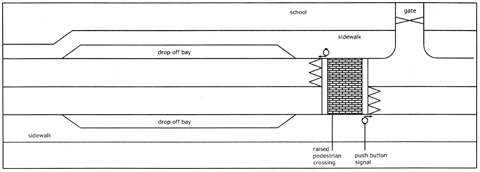
A proposal for traffic calming in a school zone. |
He outlined ways and means for traffic calming in four different types of areas in need of such action. Madras Musings publishes the proposal for a school zone in this issue and will in the next three issues carry the other proposals. The meeting was organised by S. Viswanathan, Editor, Industrial Economist, and any school or residential or shopping association interested in having a traffic calming plan introduced in its area could contact Viswanathan on +91 44 2250 1235 / +91 44 4212 0018 or e-mail viswanathan.ie@gmail.com
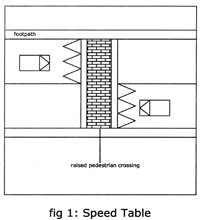
Methods of traffic calming:
Speed Table |
The meeting agreed that the law of the jungle was the only law in operation on our streets these days. There was no realisation among citizens that traffic rules were meant for their own safety. The right of way was asserted by the size and the speed of a vehicle rather than by adherence to rules. It was felt that the present negative practices, such as overspeeding, reckless driving and violation of safety rules, could not be curbed merely by introducing more stringent regulations to control the vehicles. Alternative solutions were necessary.
Dr. Srinivasan felt that this could be best achieved by modifying the traffic environment in such a way that it would “calm down drivers”. The term ‘traffic calming’ has evolved from the German word ‘Verkehrsberuhigung’, he said; it refers to the methods of changing the behaviour of motorists in accordance with the characteristics of the area in which they drive. These methods have been found to help in reducing vehicle speed, improving road safety, and enhancing the quality of life.
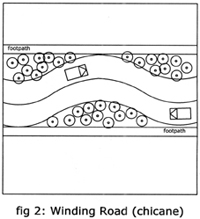
Methods of traffic calming:
Winding Road (chicane) |
Residential areas constitute the largest and the most important land use in cities. As much as 80 per cent of the total trips within the urban region either originate from or are headed for destinations in the city. Moreover, residential streets account for about 75 per cent of the entire urban road system. According to the standards of the Indian Roads Congress, the minimum width of a residential street should be 5.50 metres with 1.50 metres wide footpaths on either side. For congenial environmental conditions, speed on these roads should be restricted to 30 kmph, and peak hour traffic volume should not exceed 325 passenger car units. But most of our residential streets are a far cry from this.
Traffic calming measures in this context should include diversion of through and truck traffic, volume control, speed control, horizontal control, narrowing down, streetscape changes and visual cues, said Dr. Srinivasan. Government authorities, local residents, voluntary organisations, industries and sponsoring agencies should be involved in planning, execution, monitoring and evaluation of such projects. The success of any such project depended to a great extent on the participation and cooperation of the local citizens.
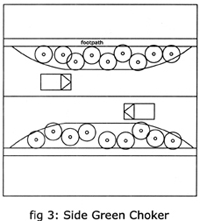
Methods of traffic calming:
Side green choker |
Traffic calming will reduce the volume and speed of traffic, while encouraging pedestrians, young children and old people to share the street. Such schemes, along with cityscape changes and visual cues, will go a long way towards improving the quality of life in residential areas, the meeting agreed and decided to take up one or two pilot projects, starting with a school zone.
Nowadays, the safety of children is not given adequate importance, especially in school zones, which face acute traffic problems, besides being places of frequent accidents. Traffic calming in a school zone would include diverting through and truck traffic from the area, reducing occurrence of excessive speeding, reducing noise, vibration and air pollution, minimising accidents and providing a safer environment for pedestrians and children.
Measures to ensure this should include:
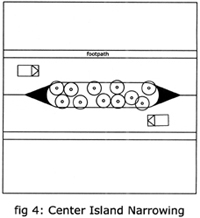
Methods of traffic calming:
Centre island narrowing |
i) Diversion of through traffic, especially truck traffic, from access road to school, by the introduction of appropriate traffic control and regulation measures.
ii) Introduction of one-way traffic regulation on the access road, at least during the school opening and closing hours, with a view to reducing traffic volume.
iii) Improvement of access road by providing wider sidewalks, a raised pedestrian crossing close to the school gate, a pedestrian refuge island in the middle of the pedestrian crossing, a pedestrian-operated push button traffic signal, a drop-off bay for children on either side, speed humps on either end of the approach road, railing barriers to control the movement of pedestrians, reflective road signs and road markings. The figure on page 1 shows a typical example of traffic improvements in a school zone.
iv) School children to be trained as a School Safety Patrol, and assigned the task of regulating the movement of children at the opening and closing time of the school.
v) Teachers to be trained in road safety, so that they can take overall control of the safety of children.
(Next fortnight: A residential zone)
|